|
 |
IN SEARCH OF LOST TIME and HARBOUR
LIGHTS
Inspired by the Richard Diebenkorn exhibition at the Royal
Academy, I began to rework two unfinished hard-edge
paintings which had not been considered successful. They now
demonstrate a very different kind of development from basic
geometrical forms. They can be hung horizontally or
vertically. |
 |
IN SEARCH OF LOST TIME and HARBOUR
LIGHTS
Inspired by the Richard Diebenkorn exhibition at the Royal
Academy, I began to rework two unfinished hard-edge
paintings which had not been considered successful. They now
demonstrate a very different kind of development from basic
geometrical forms. They can be hung horizontally or
vertically. |
 |
TOTEM 3
Although in no way descriptive, this painting is the outcome
of a fascination with native American totem poles seen on
several occasions. |
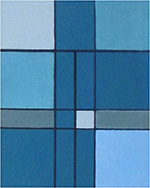 |
SMALL WHITE SQUARE
The most recent and final painting in the ‘White Square’
series. |
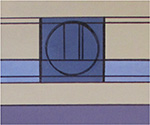 |
MYSTERIOUS CIRCLE
This harks back to earlier work in which the triangle, and
then the circle, were the dominant shapes. It relates to the
many circular forms used as symbols throughout the ages and
throughout the world. |
 |
GOLDEN NUMBER
This painting relates to the symbol for ‘Golden Number 18’,
which appears in medieval almanacs for calculating phases of
the moon. Scandinavian in origin, the so-called ‘clog
almanacs’ were based on even earlier moon calendars. |
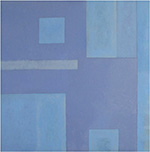 |
ALL’S BLUE
The title comes from Browning. ‘I find earth not grey but
rosy, Heaven not grim but fair of view, Do I stoop? I
pluck a posy, Do I stand and stare? All’s blue. |
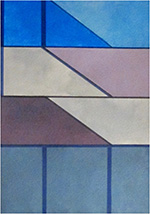 |
TANOSHIMI
Japanese for ‘entertainment’ or ‘amusement’. The painting
refers to a busker once seen in Covent Garden, who had
developed a sort of ‘juggling act involving wooden bricks. |
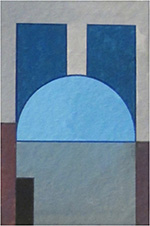 |
NINEVEH
Based on a detail from an Assyrian stone carving showing
labourers pulling carts in front of stylised trees and
buildings. Nineveh was near the city of Mosul in present-day
Iraq. |
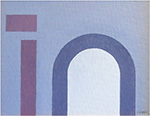 |
ARCHWAY 3
Loosely derived from memories of arches and architectural
fragments seen in Rome and elsewhere. |
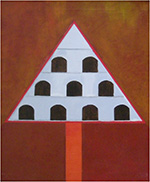 |
PARALLEL MEANINGS 1 : DOVECOT
One of a series of paintings which are to a certain extent
ambiguous and can be interpreted in different ways. It is
based on an actual dovecot, but could be seen as a strange
road-sign warning of multiple tunnels ahead! |
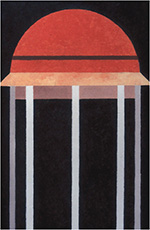 |
MAHARAJAH’S WELL
A result of genealogical research. A well was presented to
the inhabitants of Stoke Row in Buckinghamshire, my English
grandmother’s birthplace, by the Maharajah of Benares in
1836. The Maharajah had become friendly with the British
Commissioner, who told him of the hardships faced by
villagers back home during the dry seasons. |
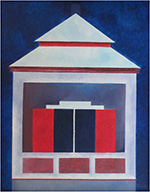 |
SKANSEN 2
Skansen is an open-air museum in Stockholm where old
buildings from all over Sweden have been reconstructed. This
painting is based on one particular example. |
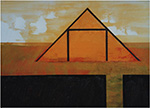 |
OLD KINGDOM
A painting which began by using the triangle as a basic
motif. As it progressed it began to suggest an Egyptian
pyramid so that idea was developed further. The cloud shapes
set it in place with the horizon below. Nevertheless it
remains basically an abstract composition in orange and
brown. |
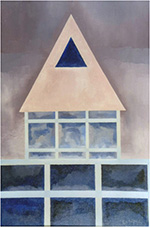 |
TEKONA and TOKAIDO
In a country prone to earthquakes , many small Japanese
buildings have not been made to last, and these paintings
are concerned with the flimsy nature of their construction.
I found the simplicity and transparency particularly
attractive. |
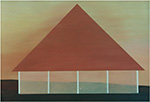 |
TEKONA and TOKAIDO
In a country prone to earthquakes , many small Japanese
buildings have not been made to last, and these paintings
are concerned with the flimsy nature of their construction.
I found the simplicity and transparency particularly
attractive. |
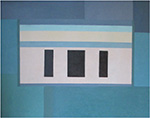 |
HOUSE OF TORTOISES
A Mayan building which takes its name from the tortoises
carved in relief on the upper cornice. The painting
eliminates such details and concentrates on the basic
proportions. |
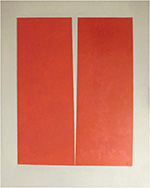 |
TIME PRESENT and TIME PAST
While in Japan, along with some ceramic pots, I bought a
section of bamboo intended as a vase. When I got home, to my
dismay, I found it had split from top to bottom. It made me
think of the sudden devastation which had befallen Hiroshima
and Nagasaki all those years before. The title is taken from
T.S.Eliot’s ‘Four Quartets’. |
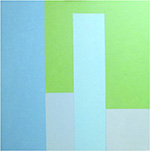 |
WARI
The starting point for this painting was the green shape,
which occurs within the repeat pattern of a textile woven in
the Peruvian War style. Weaving techniques in the ancient
Andes varied from region to region. |
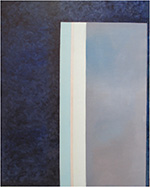 |
FENESTRA
Fenestra is Latin for window. Although this arrangement
began as a doorway, the section on the right began to look
like glass. It became an example of painting taking on a
life of its own. |
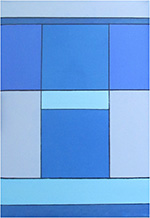 |
SINGING THE BLUES
A celebration of the colour blue, with all its historical
associations, and the powerful effect it can exert on the
senses. |
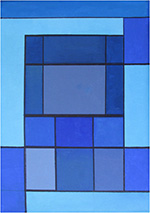 |
INVERSION
The title refers to the fact that this purely abstract
composition was at some stage turned upside down! |
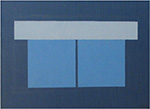 |
WAREHOUSE
A simple arrangement based on an actual warehouse in Kent,
which had features common to many such industrial buildings. |
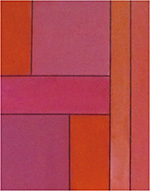 |
STUDY IN RED
Red, in addition to blue, in all its variations, can be a
colour with a special meaning for many people. |
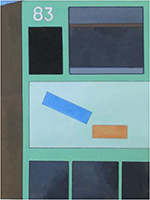 |
HONG KONG TRAM
This tram was actually seen and photographed in Kowloon. It
made me reflect on the bus routes in London, the most
familiar numbers of which are associated with particular
places and memories. (For me, 73 and 88). |
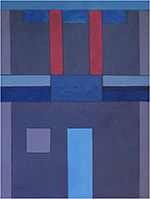 |
IRIGUCHI
‘Entrance’. This painting was originally inspired by the
dovecot at Kentwell Hall, a restored Elizabethan manor house
in the Suffolk countryside - one of the most atmospheric
stately homes I have ever visited. The layout went through
so many changes it bears little resemblance to the original
subject. |
 |
KIIRO and KOSEI
Kiiro is Japanese for yellow. Kosei means individuality, and
with an accent on the ‘o’ it can mean composition. I find
certain words in other languages fascinating, and often use
them as titles. Together with ‘White Square’ and ‘White
Square 2’ these small paintings are a response to the
enormous geometrical works of the recent past which often
seemed to rely entirely on scale for their effect. |
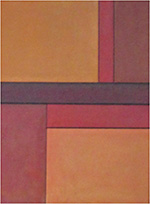 |
KIIRO and KOSEI
Kiiro is Japanese for yellow. Kosei means individuality, and
with an accent on the ‘o’ it can mean composition. I find
certain words in other languages fascinating, and often use
them as titles. Together with ‘White Square’ and ‘White
Square 2’ these small paintings are a response to the
enormous geometrical works of the recent past which often
seemed to rely entirely on scale for their effect. |
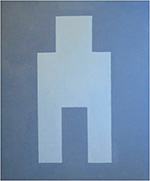 |
SPADE MONEY
A coin used in China between around 1050 and 250 BC. They
came in a variety of shapes based on spades and tools which
had earlier been used to barter for other goods. This one is
an example seen in the Fitzwilliam Museum, Cambridge. |
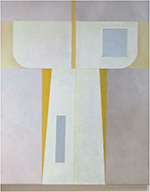 |
UCHIKAKE
A traditional Japanese wedding dress from the Middle Edo
period. They were sometimes decorated with poems. |
 |
OSTIUM
One of several paintings based on doorways, the recurrent
theme being ‘What lies Beyond’. |
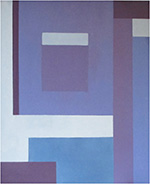 |
HIMEJI
Himeji is the name of a castle in the city of Kyoto, which
belonged to a famous war-lord and was rebuilt around 1600.
The painting is based on the structure of a room featuring
massive horizontal and vertical beams. |
 home
about
artists
exhibitions
press
contact
purchase
home
about
artists
exhibitions
press
contact
purchase home
about
artists
exhibitions
press
contact
purchase
home
about
artists
exhibitions
press
contact
purchase